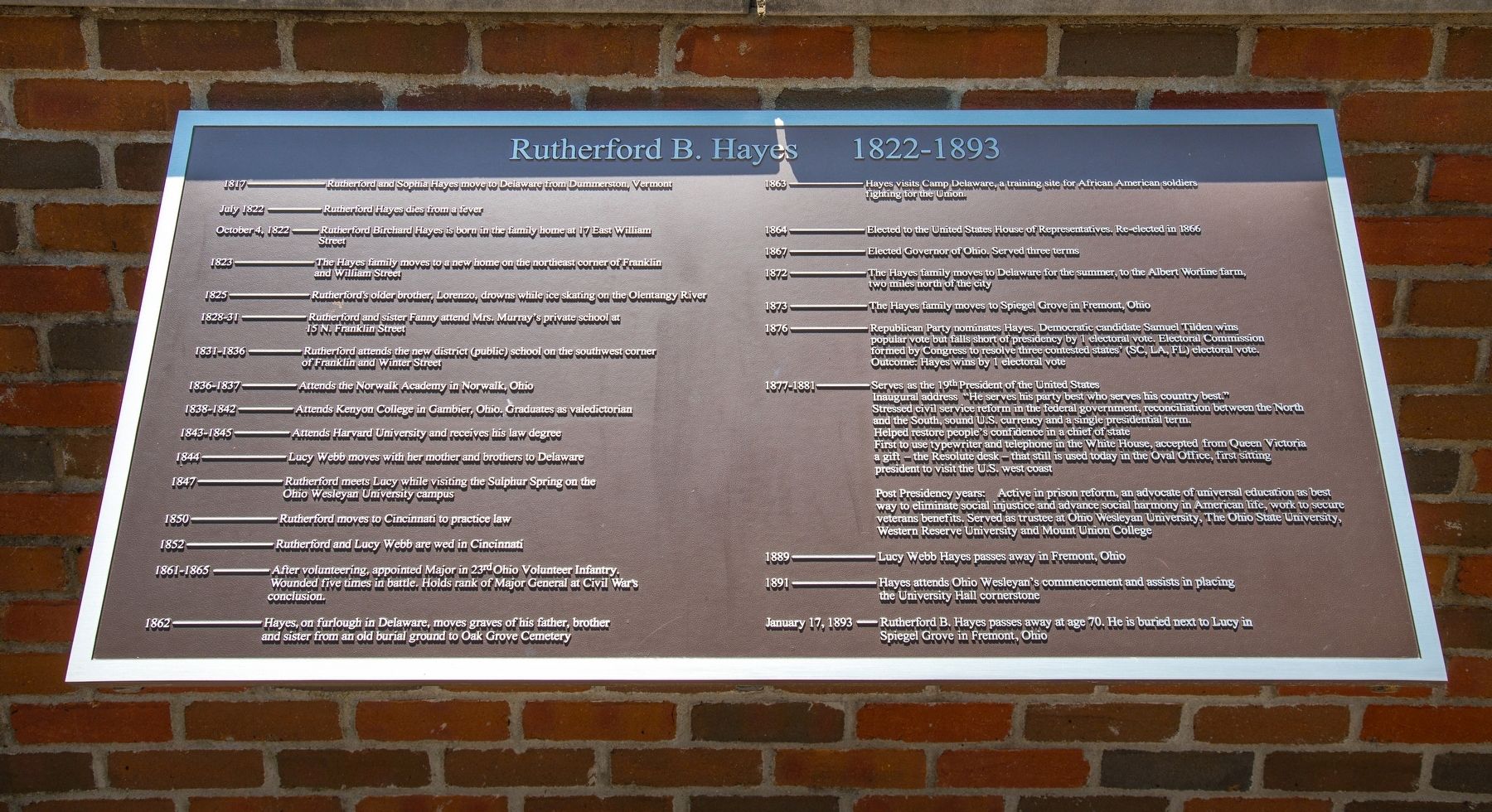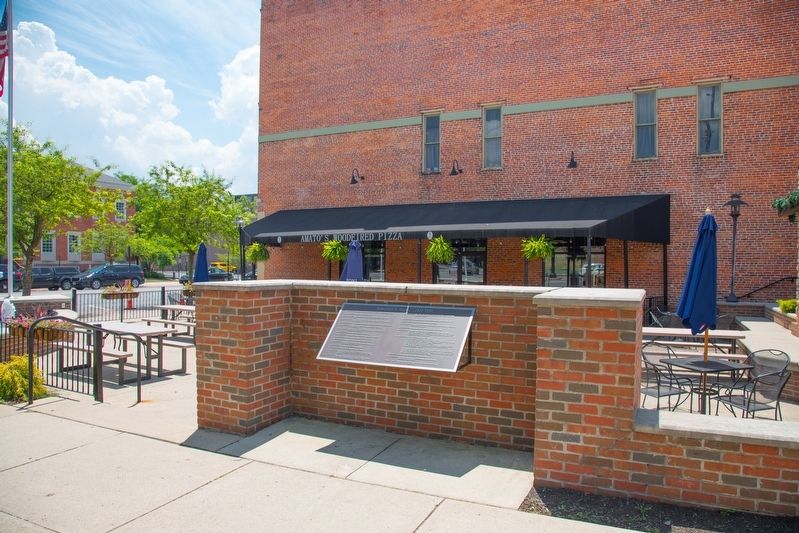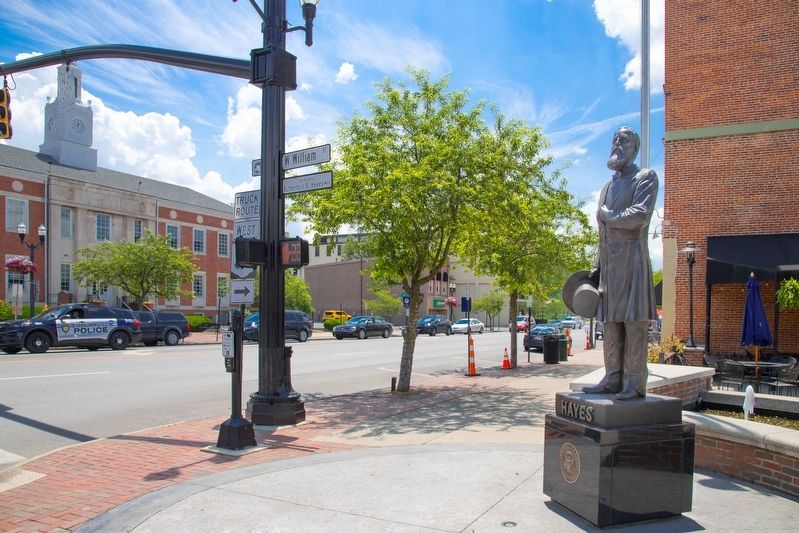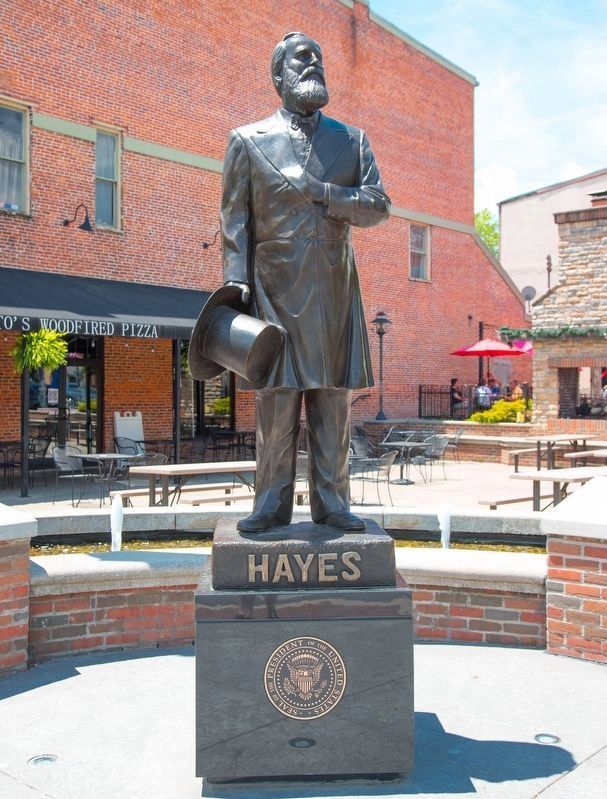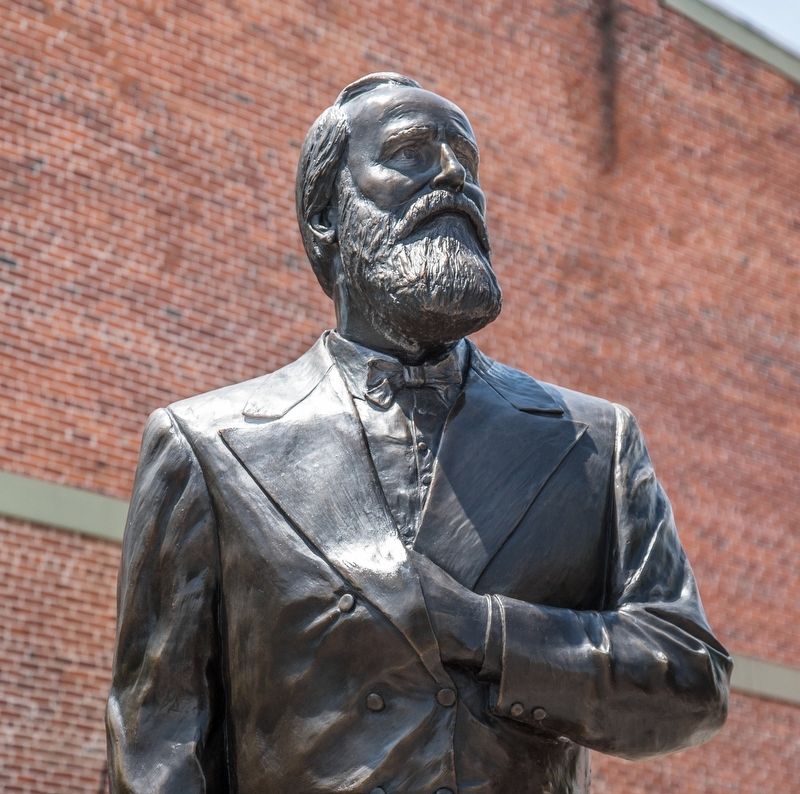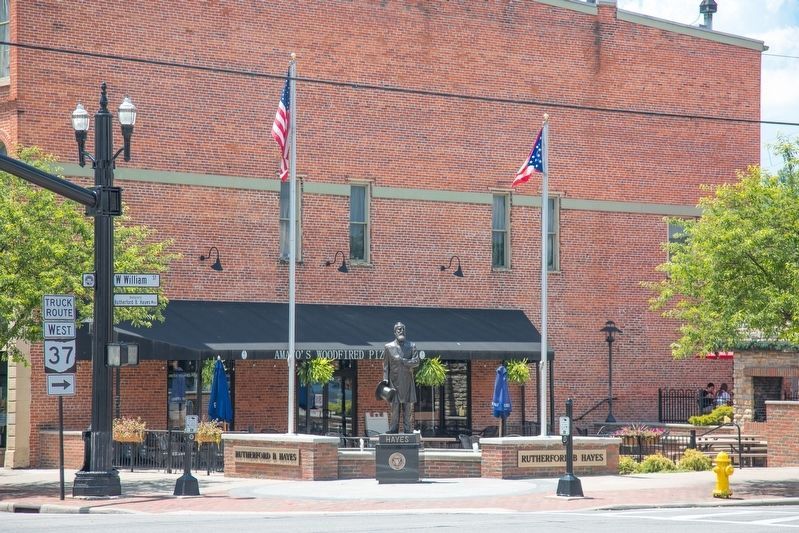Delaware in Delaware County, Ohio — The American Midwest (Great Lakes)
Rutherford B. Hayes
1822–1893
1817 • Rutherford and Sophia Hayes move to Delaware from Dummerston, Vermont
July 1822 • Rutherford Hayes dies from a fever
October 4, 1822 • Rutherford Birchard Hayes is born in the family home at 17 East William Street
1823 • The Hayes family moved to a new home on the northeast corner of Franklin and William Street
1825 • Rutherford’s older brother, Lorenzo, drowns while ice skating on the Olentangy River
1828-31 • Rutherford and sister Fanny attend Mrs. Murray’s private school at 15 N Franklin Street.
1831-1836 • Rutherford attends the new district (public) school on the southeast corner of Franklin and Winter Street.
1836-1837 • Attends the Norwalk Academy in Norwalk, Ohio
1838-1842 • Attends Kenyon College in Gambier, Ohio. Graduates as valedictorian
1843-1845 • Attends Harvard University and receives his law degree
1844 • Lucy Webb moves with her mother and brothers to Delaware
1847 • Rutherford meets Lucy while visiting the Sulphur Spring on the Ohio Wesleyan University campus.
1850 • Rutherford moves to Cincinnati to practice law
1852 • Rutherford and Lucy Webb are wed in Cincinnati
1861-1865 • After volunteering, appointed Major in 23rd Ohio Volunteer Infantry. Wounded five times in battle. Held rank of Major General at Civil War’s conclusion.
1862 • Hayes, on furlough in Delaware, moves graves of his father, brother and sister from an old burial ground to Oak Grove Cemetery.
1863 • Hayes visits Camp Delaware, a training site for African American soldiers fighting for the Union
1864 • Elected to the United States House of Representatives. Re-elected in 1866
1867 • Elected Governor of Ohio. Served three terms.
1872 • The Hayes family moves to Delaware for the summer, to the Albert Worline farm, two miles north of the city
1873 • The Hayes family moves to Spiegel Grove in Fremont, Ohio
1876 • Republican Party nominates Hayes, Democratic candidate Samuel Tilden wins popular vote but falls short of presidency by 1 electoral vote. Electoral Commission formed by Congress to resolve three contested states’ (SC, LA, FL) electoral vote. Outcome: Hayes wins by 1 electoral vote.
1877-1881 • Serves as 19th President of the United States • Inaugural address “He serves his party best who serves his country best.” • Stressed civil service reform in the federal government, reconciliation between the North and South, sound U.S. currency and a single presidential term. • Helped restore people’s confidence in a chief of state • First to use typewriter and telephone in the White House • accepted from Queen Victoria a gift—the Resolute desk—that still is used today in the Oval Office • first sitting president
to visit the U.S. west coast • Post Presidency years: Active in prison reform, an advocate of universal education as best way to eliminate social injustice and advance social harmony in American life, work to secure veteran benefits. Served as trustee at Ohio Wesleyan University, The Ohio State University, Western Reserve University and Mount Union College
1889 • Lucy Webb Hayes passes away in Fremont, Ohio
1891 • Hayes attends Ohio Wesleyan’s commencement and assists in placing the University Hall cornerstone.
January 17, 1893 • Rutherford B. Hayes passes away at age 70. He is buried next to Lucy in Spiegel Grove in Fremont, Ohio.
Erected 2019 by Rutherford B. Hayes Heritage Fund.
Topics and series. This historical marker is listed in this topic list: Government & Politics. In addition, it is included in the Former U.S. Presidents: #19 Rutherford B. Hayes series list. A significant historical date for this entry is October 4, 1822.
Location. 40° 17.921′ N, 83° 4.087′ W. Marker is in Delaware, Ohio, in Delaware County. Marker is at the intersection of West William Street (U.S. 36) and South Sandusky Street, on the left when traveling west on West William Street. Touch for map. Marker is in this post office area: Delaware OH 43015, United States of America. Touch for directions.
Other nearby markers. At least 8 other markers are within walking distance of this marker. Old City Hall and Opera House (within shouting distance of this marker); Frederick Douglass And William Tecumseh Sherman Spoke Here (about 300 feet away, measured in a direct line); African-American Civil War Soldiers (about 300 feet away); Rutherford B. Hayes Birthplace (about 400 feet away); William Street United Methodist Church / Rutherford B. Hayes, 19th President of the United States (about 400 feet away); 41 North Sandusky Street (about 500 feet away); Mrs. Murray’s School (about 500 feet away); Delaware Run Storm Net (about 600 feet away). Touch for a list and map of all markers in Delaware.
Also see . . . Wikipedia entry for Rutherford B. Hayes. Excerpt:
A lawyer and staunch abolitionist, he had defended refugee slaves in court proceedings during the antebellum years.(Submitted on June 21, 2020.)
The Republican Party nominated Hayes as its candidate for the presidency in 1876, where he won through the Compromise of 1877 that officially ended Reconstruction by leaving the South to govern itself. In office he withdrew military troops from the South, ending Army support for Republican state governments in the South and for the efforts of African-American freedmen to establish their families as free citizens. Hayes promoted civil-service reform, and attempted to reconcile thedivisions left over from the Civil War of 1861–65 and the Reconstruction Era of 1865–77.
An attorney in Ohio, Hayes served as city solicitor of Cincinnati from 1858 to 1861. When the Civil War began, he left a fledgling political career to join the Union Army as an officer. Hayes was wounded five times, most seriously at the Battle of South Mountain in 1862. He earned a reputation for bravery in combat and was promoted to the rank of brevet major general. After the war, he served in Congress from 1865 to 1867 as a Republican. Hayes left Congress to run for governor of Ohio and was elected to two consecutive terms, from 1868 to 1872. Later he served a third two-year term, from 1876 to 1877.
In 1876 the Electoral College made Hayes president in one of the most contentious elections in U.S. history. He lost the popular vote to Democrat Samuel J. Tilden, but won an intensely disputed electoral-college vote after a Congressional commission awarded him 20 contested electoral votes. There resulted the Compromise of 1877, in which the Democrats acquiesced to Hayes's election on the condition that he withdraw remaining U.S. troops protecting Republican officeholders in the South, thus officially ending the Reconstruction era.
Hayes believed in meritocratic government and in equal treatment without regard to wealth, social standing or race. He ordered federal troops to guard federal buildings and in doing so restored order during the Great Railroad Strike of 1877. Hayes implemented modest civil-service reforms that laid the groundwork for further reform in the 1880s and 1890s. He vetoed the Bland–Allison Act (1878), which put silver money into circulation and raised nominal prices, insisting that maintenance of the gold standard was essential to economic recovery. Hayes's policy toward Western Indians anticipated the assimilationist program of the Dawes Act of 1887.
Hayes kept his pledge not to run for reelection, retired to his home in Ohio, and became an advocate of social and educational reform. Biographer Ari Hoogenboom said Hayes’s greatest achievement was to restore popular faith in the presidency and to reverse the deterioration of executive power that had set in after Abraham Lincoln’s assassination in 1865. Supporters have praised his commitment to civil-service reform and to the defense of civil rights. ...
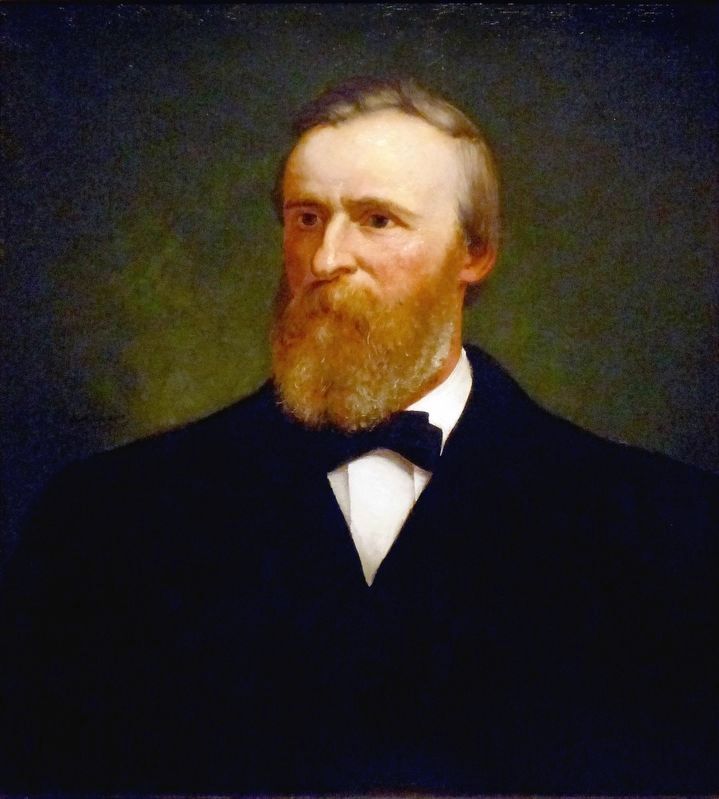
Oil by Eliphalet Andrews, National Portrait Gallery, August 9, 2015
7. Rutherford B. Hayes
This 1881 portrait by Eliphalet Andrews of Rutherford B. Hayes hangs in the National Portrait Gallery in Washington, DC.
“The presidential election of 1876 was among the closest in American history. Although Democratic candidate Samuel J. Tilden won the popular vote by 250,000, his Electoral College total was one short of the majority needed for election. Republican Rutherford B.Hayes would not concede because of disputed results in Florida, Louisiana, South Carolina, and Oregon. Both parties agreed to appoint an electoral Commission, which awarded the Florida vote and presidency to Hayes. A prior secret agreement between Republicans and Democrats made Hayes president in return for his withdrawal of federal troops from the South. This effectively ended Reconstruction and black political participation in the South and it restored the rule of the Democratic Party there. Even though he was not a strong president, Hayes did take initial steps toward curbing corruption in the civil service.
Hayes's portraitist, Eliphalet Andrews, was the founding director of Washington, D.C.'s Corcoran School of Art.” — National Portrait Gallery
“The presidential election of 1876 was among the closest in American history. Although Democratic candidate Samuel J. Tilden won the popular vote by 250,000, his Electoral College total was one short of the majority needed for election. Republican Rutherford B.Hayes would not concede because of disputed results in Florida, Louisiana, South Carolina, and Oregon. Both parties agreed to appoint an electoral Commission, which awarded the Florida vote and presidency to Hayes. A prior secret agreement between Republicans and Democrats made Hayes president in return for his withdrawal of federal troops from the South. This effectively ended Reconstruction and black political participation in the South and it restored the rule of the Democratic Party there. Even though he was not a strong president, Hayes did take initial steps toward curbing corruption in the civil service.
Hayes's portraitist, Eliphalet Andrews, was the founding director of Washington, D.C.'s Corcoran School of Art.” — National Portrait Gallery
Credits. This page was last revised on January 24, 2024. It was originally submitted on June 21, 2020, by J. J. Prats of Powell, Ohio. This page has been viewed 473 times since then and 45 times this year. Last updated on January 24, 2024, by Carl Gordon Moore Jr. of North East, Maryland. Photos: 1, 2, 3, 4, 5, 6. submitted on June 21, 2020, by J. J. Prats of Powell, Ohio. 7. submitted on August 24, 2015, by Allen C. Browne of Silver Spring, Maryland. • J. Makali Bruton was the editor who published this page.
